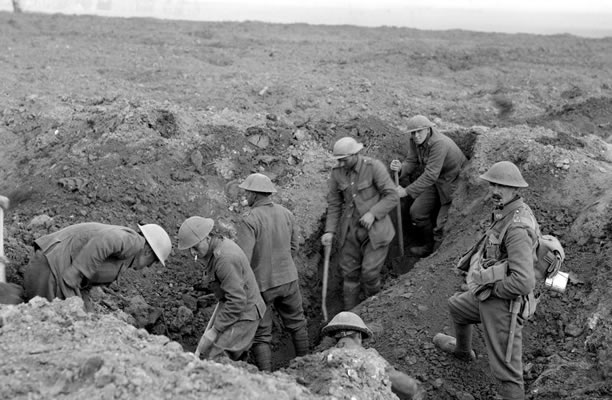
Part of the infantry of the New Zealand Expeditionary Force.
The Wellington Infantry Regiment was one of four regional infantry groupings (along with Auckland, Canterbury, and Otago) which made up the bulk of New Zealand’s infantry forces during the First World War. It served as the Wellington Battalion at Gallipoli in 1915 before being divided into 1st Wellington Infantry Battalion and 2nd Wellington Infantry Battalion in March 1916. An additional battalion, 3rd Wellington Infantry Battalion, existed between March 1917 and February 1918. All battalions of the regiment served on the Western Front from 1916 until 1918.
Wellington Infantry Battalions
| Name | Unit attached to (dates) | Campaigns | Further information |
|---|---|---|---|
| Wellington Battalion | New Zealand Infantry Brigade (Aug 1914 - Mar 1916) | Gallipoli | Unit diaries at Archives New Zealand; Unit diaries at Australian War Memorial |
| 1st Battalion Wellington Infantry Regiment (1/WIR) | 1st New Zealand Infantry Brigade (Mar 1916 - Feb 1919) | Western Front: Somme 1916; Messines 1917; Passchendaele 1917; Spring Offensive and Advance to Victory 1918 | Unit diaries at Archives New Zealand |
| 2nd Battalion Wellington Infantry Regiment (2/WIR) | (a) 2nd New Zealand Infantry Brigade (Mar-Dec 1916) (b) 1st New Zealand Infantry Brigade (Jan 1917 - Feb 1918 | Western Front: Somme 1916; Messines 1917; Passchendaele 1917; Spring Offensive and Advance to Victory 1918 | Unit diaries at Archives New Zealand |
| 3rd Battalion Wellington Infantry Regiment (3/WIR) | 4th New Zealand Infantry Brigade (Mar 1917 - Feb 1918) | Western Front: Somme 1916; Messines 1917; Passchendaele 1917 | Unit diaries at Archives New Zealand |
| Wellington Regt training/reserve battalion, (1916) | New Zealand Reserve Group/ New Zealand Infantry (Reserve) Brigade (1916-19) | Training unit based at Sling Camp in England | Unit diaries at Archives New Zealand |
Cloth patches, shoulder titles and pugarees
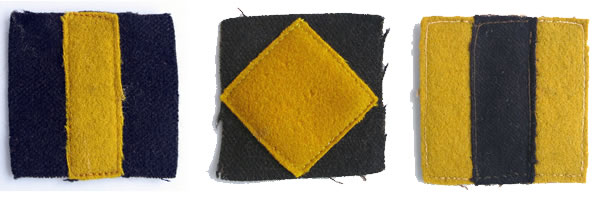
Cloth patches for the (l to r) 1st, 2nd and 3rd Battalions of the Wellington Infantry Regiment.
Cloth patches sewn on the backs of uniform jackets from October 1916 identified which unit – or part of a unit – an individual belonged to. These are the patches of the three Wellington battalions serving on the Western Front, plus the fourth (reserve) battalion based at Sling Camp in England.

Shoulder title worn by all infantry units (‘New Zealand Rifles’) except the New Zealand Rifle Brigade.

All New Zealand infantry units wore red-striped puggarees (felt hatbands) on their caps.
Wellington infantry companies
The Wellington Infantry Battalion (later the 1st, 2nd, and 3rd Wellington Infantry Battalions) was made up of four companies, each with around 227 men. Here are their badges:
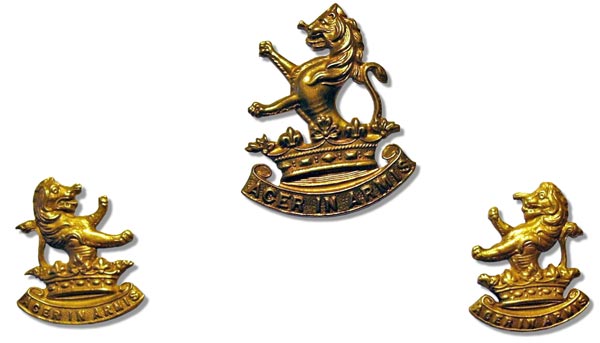
7th (Wellington West Coast) Company. Cap and collar badges: A coronet surmounted by a lion rampant. Motto: Acer in armis (Strong in arms).
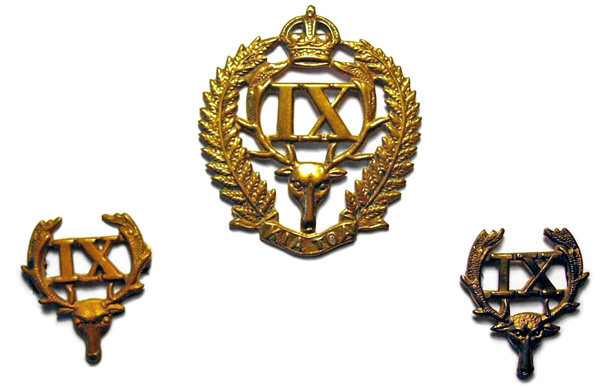
9th (Hawke’s Bay) Company. Cap badge: A red deer’s head within a fern-wreath surmounted by a crown. Collar badges: Similar to the cap badge but without the fern-wreath. Motto: Kia toa (Be brave).
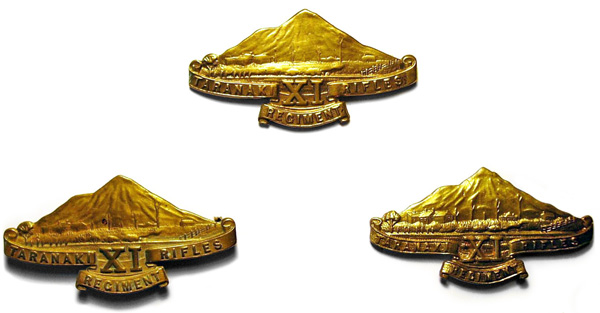
11th (Taranaki) Company. Cap and collar badges: Image of Mt Egmont/Taranaki. Collar badges: Smaller version of the cap badge. Motto: Primus in armis (First in arms).
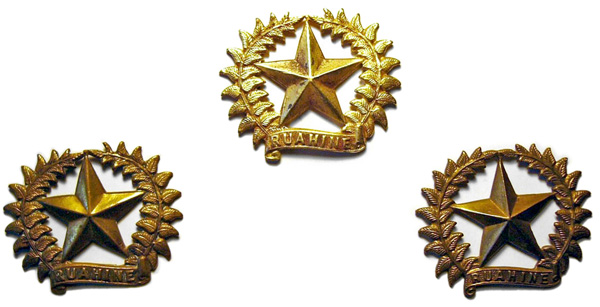
17th (Ruahine) Company. Cap and collar badges: A five-pointed star flanked by fern-fronds, with scroll ‘Ruahine’ beneath. Motto: Ad unum omnes (Together as one).
Formation of the companies
The Wellington Battalion was divided into 1st Wellington Battalion and 2nd Wellington Battalion in March 1916, with the second battalion made up of a new set of companies with the same names as the first. A third battalion, the 3rd Wellington Battalion, existed from March 1917 till February 1918.
The Wellington units drew their recruits from the Wellington military district, which encompassed the Taranaki, Whanganui, Manawatu, East Coast, Poverty Bay, Hawke’s Bay, Wairarapa and Wellington city regions.
As far as possible, each company drew its recruits from its geographical region until September 1917. From then on, men were sent overseas as generic infantry reinforcements but were still generally assigned to their region’s unit.
The four companies were NZEF counterparts of the regional Territorial regiments created in March 1911. They adopted the identifying badge of the corresponding Territorial unit.
Each regional infantry company had its own distinctive cap and collar badges (the cap badge is shown in the centre of each photo). They continued to be worn by the Wellington companies after the second and third battalions were formed, with cloth patches signifying which battalion they belonged to.
The 5th (Wellington Rifles) Regiment was the only Territorial Force infantry regiment not represented by name in the New Zealand Division. It had sent a company to Samoa in 1914, and in 1915 the battalions of the New Zealand Rifle Brigade were recruited from its district (among others).
Further reading
- Cunningham, W.H., C.A.L.Treadwell and J.S. Hanna, The Wellington Regiment, N.Z.E.F., 1914–1919 (Wellington: Ferguson and Osborn, 1928; reprinted by Naval & Military Press, Uckfield, East Sussex, 2005)

Community contributions